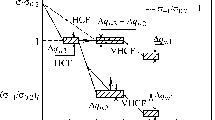Abstract
Al2618 high-strength aluminum alloy was subjected to precipitation hardening at T6 tempering conditions to improve its mechanical properties for employing it as the spacecraft skin material. Nine specimens of Al2618 artificially aged alloy were prepared according to the ASTM-E606/E606M-12 standard and tested through the S-N curve method. It resulted in the fatigue strength of Al2618 being 150 MPa, which is better than the existing Al2024-T3 alloy by about 8.7%. An increment of 59.9% and 3.2% of fatigue life and fatigue strength for the infinite fatigue life of the alloy was identified through the Basquin Equation and Kohout-Věchet method, respectively, in correspondence with Al2024-T3. The fractographic analysis of the broken materials was investigated with the support of SEM images; the failure mechanism and causes for the failures were discussed.









Similar content being viewed by others
References
Georgantzia E, Gkantou M, and Kamaris G S, Eng Struct (2021). https://doi.org/10.1016/j.engstruct.2020.111372
Bouzekova-Penkova A, and Miteva A, Bulg Acad Sci-Space Res Technol Inst-Aerosp Res Bulg (2022). https://doi.org/10.3897/arb.v34.e15
Liu L, Pan Q, Wang X, and Xiong S, J Alloys Compd (2018). https://doi.org/10.1016/j.jallcom.2017.11.070
Liu G, Wang Q, Liu T, Ye B, Jiang H, and Ding W, Mater Sci Eng: A (2017). https://doi.org/10.1016/j.msea.2017.04.072
Yu K, Li W, Li S, and Zhao J, Mater Sci Eng: A 1–2 (2004) 88–93. https://doi.org/10.1016/j.msea.2003.09.092
Malek B, Mabru C, and Chaussumier M, Int J Fatigue (2020). https://doi.org/10.1016/j.ijfatigue.2019.105322
Zamarripa A S, Pinna C, Brown M, Mata M G, Morales M C, and Beber-Solano T, Mater charact 12 (2011) 1141–1150. https://doi.org/10.1016/j.matchar.2011.09.005
Estrin Y, Dyskin A V, Pasternak E, Khor H C, and Kanel-Belov A J, Philos Mag Lett 6 (2003) 351–355. https://doi.org/10.1080/0950083031000120873
Mouritz A P, Introduction to aerospace materials, Elsevier, Amsterdam (2012).(ISBN: 0857095153).
Uyanna O, and Najafi H, Acta Astronaut (2020). https://doi.org/10.1016/j.actaastro.2020.06.047
ASTM A, Standard test method for strain-controlled fatigue testing. ASTM international, West Conshohocken (PA USA): Book of Standards (2012). https://doi.org/10.1520/E0606_E0606M-21
ASTM E, Standard guide for electrolytic polishing of metallographic specimens (2009). https://doi.org/10.1520/E1558-09R21
Johannesson P, Svensson T, and De Mare J, Int J Fatigue 8 (2005) 954–965. https://doi.org/10.1016/j.ijfatigue.2004.11.009
Almaraz G M D, Lemus V H M, and Lopez J J V, Proced Eng 1 (2010) 805–813. https://doi.org/10.1016/j.proeng.2010.03.087
Kwofie S, and Chandler H, Int J Fatigue 12 (2007) 2117–2124. https://doi.org/10.1016/j.ijfatigue.2007.01.022
Alalkawi H J, Alhamdany A A, and Hassan M R A, Al-Nahrain J Eng Sci 1 (2018) 141–146. https://doi.org/10.29194/NJES21010141
Cui W, J Mar Sci Technol (2002). https://doi.org/10.1007/s007730200012
Ravanan A, Palanivel I, and Kulendran B, Chiang Mai J Sci 4 (2022) 1217–1232. https://doi.org/10.12982/CMJS.2022.066
Cree A, Devlin M, Critchlow G, and Hirst T, Trans IMF 6 (2010) 303–310. https://doi.org/10.1179/002029610X12734927543067
Zhou J, Xu S, Huang S, Meng X, Sheng J, Zhang H, Li J, Sun Y, and Boateng E A, Metals 11 (2016) 279. https://doi.org/10.3390/met6110279
Handbook A, volume 12: fractography (1987) p 654, ISBN: 9780871700186.
Pedersen K O, Westermann I, Furu T, Børvik T, and Hopperstad O S, Mater Design (2015). https://doi.org/10.1016/j.matdes.2014.12.035
Collins J A, Failure of materials in mechanical design: analysis, prediction, prevention, John Wiley & Sons, Hoboken (1993).(ISBN: 0471558915).
Funding
Not applicable.
Author information
Authors and Affiliations
Contributions
The authors confirm contribution to the paper as follows: study conception and design were contributed by Arivumani Ravanan; data collection was contributed by Arivumani Ravanan; analysis and interpretation of results were contributed by Arivumani Ravanan; draft manuscript preparation was contributed by Ilamathi Palanivel and Balamurugan Kulendran. All authors reviewed the results and approved the final version of the manuscript.
Corresponding author
Ethics declarations
Conflict of interest
All authors certify that they have no affiliations with or involvement in any organization or entity with any financial interest or non-financial interest in the subject matter or materials discussed in this manuscript.
Additional information
Publisher's Note
Springer Nature remains neutral with regard to jurisdictional claims in published maps and institutional affiliations.
Rights and permissions
Springer Nature or its licensor (e.g. a society or other partner) holds exclusive rights to this article under a publishing agreement with the author(s) or other rightsholder(s); author self-archiving of the accepted manuscript version of this article is solely governed by the terms of such publishing agreement and applicable law.
About this article
Cite this article
Ravanan, A., Palanivel, I. & Kulendran, B. Fatigue and Fractographic Analysis of Artificially Aged 2618 Wrought Aluminum Alloy. Trans Indian Inst Met (2024). https://doi.org/10.1007/s12666-024-03335-7
Received:
Accepted:
Published:
DOI: https://doi.org/10.1007/s12666-024-03335-7




